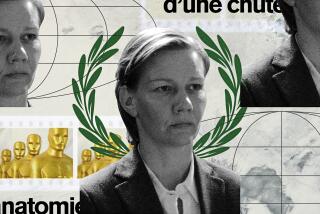Column: Patt Morrison asks Janice Min: Power-lister
Every year since 1992, the Hollywood Reporter has opened its own version of the Oscars envelope: a ranked “power” list of the top 100 women in entertainment. It happens again today, at a gala breakfast at Milk Studios, but with a difference: no 1-to-100 rankings. Janice Min, the Hollywood Reporter’s president and chief creative officer, says she made the change because the list wasn’t doing what it was meant to — advance women in Hollywood. It’s already been a big year for the cause: Patricia Arquette, Jennifer Lawrence and Jessica Chastain have inveighed against the film industry’s gender-tilted playing field. Min hopes the new list will add to the leveling effort.
Some of the most brilliant minds in Hollywood [were] warring about their status versus someone else, instead of the bigger issue for women and how we could take action.
Why so little progress for women in Hollywood?
It’s the culture of Hollywood, the nature of Hollywood. Anyone in Hollywood wants to hang on to power and their job no matter what. That makes the town risk-averse. It makes people hire who they know, and that very often could put more men in contention for those jobs, jobs in front of and behind the camera.
What made you rethink the rankings list?
I had a breakfast with a prominent female in the industry who said, “Have you ever thought about unranking the list?” At first, my cynical mind thought it was because this person didn’t want to come in at Number Whatever versus No. 1. But we had a more substantive conversation, and I thought the moment was right to do this.
Our list [with rankings] was not getting more women directors hired. It wasn’t getting more women in top executive suites. It was just its own little novelty act. The worst part was the pitting of women against each other.
You used the phrase “female cage match.”
Yes, some of the most brilliant minds in Hollywood [were] warring about their status versus someone else, instead of the bigger issue for women and how we could take action.
I get it. Who doesn’t want to go around saying they’re the most powerful whatever? For someone in a contract negotiation, that could probably end up amounting to millions of dollars, or more leverage to fly in a private jet. Name one man who wouldn’t [bargain that way].
How will your list be presented henceforth?
There will be a list of the year’s top power players —not a specific number — of people having a huge year and the difference they make. We have TV people, film people, digital people, the deal makers separated into categories, and alphabetical within categories.
Was there a moment when you realized how much women were investing in the rankings?
Seeing someone I like very much show up a few years ago at the [ red carpet [for the list announcement event], see her rankings — she had fallen — burst into tears, and turn around and leave. That’s when I began to get a real sense of how possibly destructive these sort of rankings were.
When the list began in 1992, long before you arrived at the Hollywood Reporter, was there any sense that it might not even be needed one day?
The notion was great when the list started, when Sherry Lansing had ascended to the top at Paramount. It felt like Hollywood had turned a page. The publisher at the time had written that we hoped it would serve as inspiration and encouragement to scores of other young women looking to get into Hollywood.
The amazing fact is that nothing changed. You can look at the statistics we hear over and over — the percentage of women directors, women on camera, women in executive suites — and the fact is that Hollywood lags far, far behind other industries in female representation. Hollywood is a bubble.
Part of the decision not to rank is that we’re now in a culture of what I call feminist theater. You have stars like Jennifer Lawrence pen an essay about “Why I’m not paid enough” or Lena Dunham tweets stuff pointing out sexism and the shortcomings of Hollywood. But until there are actionable measures taken, it’s just theater. This is one case where social media is our friend, the amount of pressure than can be exerted by some of the most prominent females to keep shining light on this.
The unranking of the list has drawn attention and encourages women on the list to think about how all of them, as individuals and a group, can help to change the conversation around women.
By its nature, the list also contains some good news about women in Hollywood, right?
Donna Langley [the chair of Universal Pictures] will be revealed Wednesday as our executive of the year. Look at what she has done at Universal, [at] what happens when you have a woman at the top. I don’t think Donna would say she’s an advocate for anything or anyone, but [she] can be receptive to doing female movies — the “Fifty Shades of Grey” [films]; she was receptive to “Straight Outta Compton” after another studio rejected it. Look at the multicultural casting of the “Fast and Furious” franchise — these things weren’t done because they were good for society, they were good for business, and she’s been rewarded [with] the most successful box office year in the history of Hollywood. That’s incredible. Hollywood always understands good business, and Donna has proven that in the most outstanding way possible.
What else do you see that’s encouraging for women in the industry?
That the conversation has begun. It’s like in AA: Admitting that you have a problem is the first step. I think we can admit we have a problem. We can’t underestimate the role of shame and embarrassment in Hollywood, and even if you think you’ve hired just enough women or people of color, you don’t want to be called out on the fact you haven’t [done more]. That’s enough to make people think, “Why is every person I interview for this director’s job a white man? Do I have someone in my company who can tell me about women I should also be interviewing?”
I don’t think anyone is willfully a sexist or a racist in Hollywood, but what is starting to happen is catching yourself in the hiring process, the interview process, the casting process, saying “Have I done what I think I should do?” I think you’ll see incredible results out of that.
Do film and TV treat women differently, give them different opportunities?
Yes, it’s revealing. There’s the sense that cable television used to be this horrible ghetto where no respectable man who had creative chops would work. [But it] is how women rose up through the ranks.Cable has been very fertile ground for women to seize power. When you look at a lot of the names dominant in film today, a lot of the same guys were dominant 20 years ago. It’s a longer process and in many ways it’s contracting and not expanding in the way cable TV has.
At the request of the ACLU, the federal Equal Employment Opportunity Commission is looking into gender discrimination in Hollywood. Is that helpful? Hurtful?
What could be hurtful? What could be worse than what’s going on now? Will it be taken seriously? Will it be effective? I don’t know, but to shine a light on an issue is pretty significant.
You’ve said the old list didn’t change anything. Will the new one?
I don’t know. If it changes the way three people on that 100 list behave, that’s a victory. If it means a few more female directors get hired, or you look at the representations of females on screen differently, then that’s a victory.
This interview has been edited and condensed.
Twitter: @pattmlatimes
Follow the Opinion section on Twitter @latimesopinion and Facebook
More to Read
A cure for the common opinion
Get thought-provoking perspectives with our weekly newsletter.
You may occasionally receive promotional content from the Los Angeles Times.







